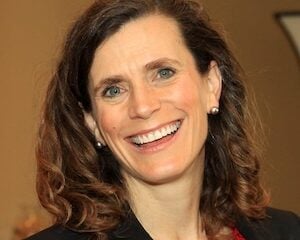Goal for Ready to Learn: engage kids and parents

 On July 11, PBS begins beaming its long-anticipated Ready to Learn service to 11 pilot stations, embarking on what planners acknowledge will be a bumpy journey toward better TV for early childhood learning.
On July 11, PBS begins beaming its long-anticipated Ready to Learn service to 11 pilot stations, embarking on what planners acknowledge will be a bumpy journey toward better TV for early childhood learning.
What comes off the bird will essentially be an expanded, repackaged version of the existing children’s service that, with the help of new educational break messages, will offer a learning-friendly environment for kids.
Off-air, outreach activities will target the audiences most critical to the task of preparing children for school–parents, teachers and child-care providers.
The on-air and off-air prongs of public TV’s Ready to Learn strategy are scaled-back versions of proposals that PBS floated at last year’s annual meeting. The estimated $72 million needed to launch a comprehensive national service has not as yet materialized.
Congress appropriated $7 million for RTL in fiscal 1996 and is considering President Clinton’s request for $10 million for the program in FY 1995. CPB, meanwhile, is preparing a fundraising campaign to drum up $35 million for RTL programming in private donations.
The shortage of funds has directly affected the start-up phase of RTL. Pilot stations have had to reassign existing staff to provide the level of outreach services needed for Ready to Learn. The planned eight hours of programming for preschoolers will instead be a nine-hour service that, while predominantly targeted toward very young children, also includes programs for school-age kids. Creation of programming for parents has been delayed until PBS can evaluate the test.
Nevertheless, observers say the TV service that American children will come to know as “PTV” represents a bold undertaking. “It’s an ambitious project, and it could really affect all of children’s television,” said Jean Chase, director of early childhood national programming for South Carolina ETV. “They’re taking it one step at a time.”
“We’re moving closer toward reaching the ultimate goal of providing better services, more quality programming and more … diversity vis a vis for young children,” said M. Parker Anderson, a childhood development specialist for the National Association for the Education of Young Children.
Starting at the breaks
PBS will introduce four new children’s series in the first seven months of the service. Both Storytime and Puzzleworks [later renamed Puzzle Place] aim to serve preschool children. The Magic School Bus and Bill Nye the Science Guy are geared for school-age kids.
The most immediate and dramatic change in what goes on the air, however, will show up in breaks between programs. Interstitial material produced by WGBH, Boston, emphasizes six educational themes that foster learning skills: information gathering or “go find out!”; experimentation/”try it out!”; recruitment skills/”ask for help!”; negotiation skills/”talk it out!”; task completion/”stick to it”; and self-esteem/”you can do it!”
“Educational experts told us this was a good place to start,” explained Jacqueline Weiss, director of the RTL project for PBS. Educational objectives are built into all PBS children’s shows; the break material will reemphasize the skills and messages that, for the most part, already are addressed in the kidvid line-up.
For preschool kids, the learning messages will be conveyed by the “P-Pals,” animated characters introduced last year as PBS began developing a seamless children’s block.
In the RTL service, these characters will reside in “PTV Park,” a visual space that contains Sesame Street, Mister Rogers’ Neighborhood and other continuing PBS children’s series. Breaks featuring real children engaged in activities also will appear next to preschool shows, which fill the weekday morning block, 7 a.m. to noon, and kick off the afternoon block at 2 p.m.
As the target audience shifts toward older kids with Reading Rainbow in the afternoon block, the break material will reflect this demographic change by featuring live-action segments, multimedia graphics and contemporary music videos within the “PTV” signature.
Different approaches developed for the break material reflect the contrasts between RTL’s target audiences. To get through to preschool kids, messages must be direct and repetitive. With school-age kids, however, they have to be fresh and remain somewhat “open for the imagination,” according to Weiss.
Off-air outreach to parents and caregivers
Adding school-age children into the audience mix “changes the focus of the project quite a bit,” said Chase. “I was hoping some of that time would have been spent with parents.”
“The only way to affect change and improve the quality of life for children is to affect the parents around them,” she added. That part of RTL, which was an original goal of the initiative, now “has a back seat.”
Parents are not possible to target “in a serious way” as a television audience because of funding, acknowledged Weiss. “We haven’t spent a lot of time focusing on this. It is a funding issue.”
Instead, parents and adults who work with children are the primary targets of RTL’s outreach component. “I see any television program for parents and childcare providers being an outgrowth of outreach,” said Alice Cahn, director of children’s programming for PBS. Research on RTL’s pilot phase will help determine what types of shows for parents would be most effective, she said. The best RTL uses of television for parents, for example, may turn out to be videotapes that they can view in workshops or borrow from libraries.
For the off-air elements of RTL, PBS is testing what Weiss described as the “consolidated outreach model,” a training program designed to introduce caregivers and parents to all series within the PTV lineup. Adults who participate in the workshops will learn about the educational objectives and target audiences of each show through video and print materials.
Children’s Television Workshop, which produces Sesame Street and helped to lay the groundwork for this type of outreach with its Preschool Education Project (PEP), is training pilot stations’ outreach coordinators, who, in turn, will train “community partners.” The model is based on the “domino concept,” Weiss explained. With station training, community partners such as local Head Start employees conduct workshops for caregivers and parents.
“The goal is to provide stations with something that’s usable and deals with all of our programs,” said Weiss. Participants who want more in-depth training can sign up for Sesame Street PEP or Mister Rogers’ Neighborhood childcare partnership workshops.
Two additional outreach components will be available to parents and other adults who don’t receive training. A bimonthly, bilingual “PTV” calendar that highlights upcoming shows and suggests activities to foster children’s learning will be the most widely distributed print piece. In addition, WGTE, Toledo, is publishing PTV Family Times, a bimonthly magazine that offers tips for parents and suggests age-appropriate activities for children.
Adult and child interaction is the top objective of RTL, said Weiss. “Whatever we’re doing, the goal is really to get adults to spend more time with their children in some kind of activity, whether that be reading to the child, taking a trip to the library, doing activities from Mister Rogers’ activity book or talking about Sesame Street after watching the show. Those are the things that are going to improve children’s skills when they reach school.”
Wish list
What monies have been available to PBS for RTL start-up have come from CPB and the EON Corp. Their grants have gone into the educational break messages, research and development of the outreach components, said Weiss.
Programming for parents is not the only element of RTL that has suffered from a shortage of funds, she added. PBS has had to limit the number of copies of calendars, kits and PTV Family Times it can distribute to stations. Pilot stations also need grants to support their personnel and other administrative costs. “All of the model sites are doing the best they can in allocating resources, but it’s a strain.”
Funds for advertising and promotion also are inadequate, especially for stations, many of which cannot afford media buys on behalf of RTL, according to Weiss. And–“somewhere down the line in the not-too-distant future”–PBS will need new educational value messages to freshen the “PTV” service; for school-age kids in particular, the existing ones will become dated fairly quickly.
CPB is supporting research on the pilot phase, which will focus on two key aspects of the test–its impact on children, parents and childcare providers, and its impact on stations.
Audience research will track use of the TV programming, and also uses of the training and supplemental print materials, according to CPB researcher Andrew Russell. For stations, the test will evaluate RTL’s impact on community support and financial contributions.
Although PBS and CPB want results as soon as possible, completion of the research will depend on how long it takes for “PTV” to settle in as an established service, with impacts that surveys can measure, Russell added.






A good example of public television.